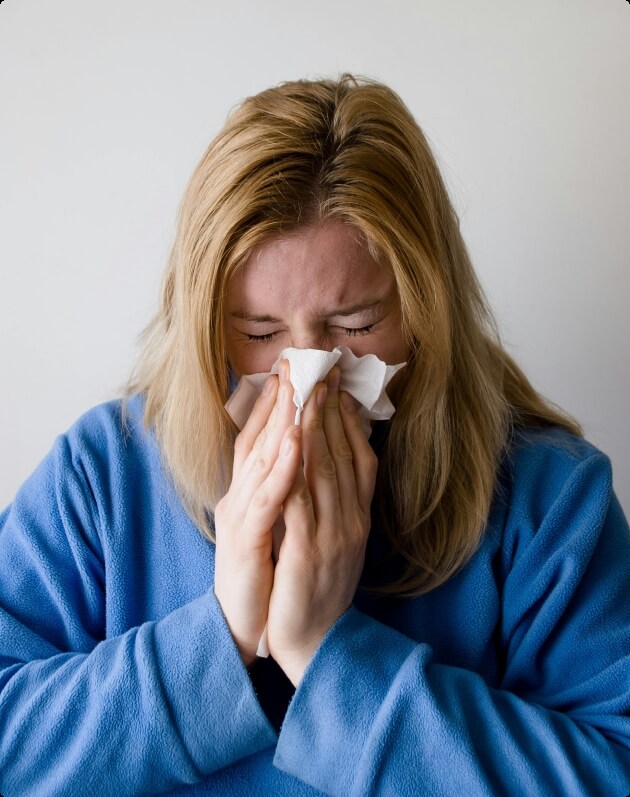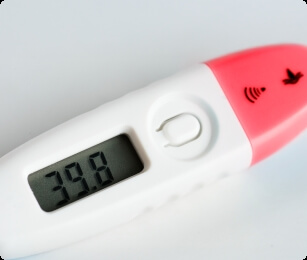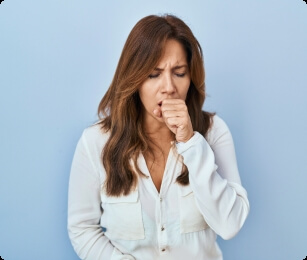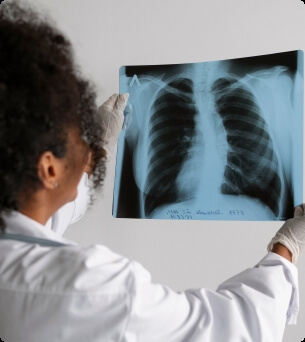Flu cases in the Netherlands are rising faster than usual, marking one of the most active seasons in recent years. At the same time, RSV, COVID-19, and other respiratory viruses continue to circulate, increasing the likelihood of co-infections and prolonged illness for many. While the flu is nothing new, this season stands out due to higher infection rates, longer recovery times, and an increased strain on healthcare services.

So, who is most at risk? And what steps can you take to stay ahead of seasonal viruses? Understanding the patterns, symptoms, and latest prevention strategies can make all the difference. Here’s what you need to know to protect yourself and those around you.
What viruses are circulating now?
Each winter brings an increase in respiratory infections, and 2025 is no exception. Several viruses are currently circulating in the Netherlands, including influenza (flu), respiratory syncytial virus (RSV), rhinovirus, and seasonal coronaviruses. According to the latest surveillance data from RIVM and NIVEL, flu cases have risen significantly, suggesting a developing flu epidemic.


Is there a flu epidemic in the Netherlands?
Yes, the Netherlands is currently experiencing a flu epidemic. In week 5 (January 27 – February 2, 2025), 118 per 100,000 inhabitants visited their GP with flu-like symptoms—an increase from 76 per 100,000 the previous week. This level has surpassed the epidemic threshold of 53 per 100,000 for three consecutive weeks, indicating sustained viral transmission.
Although flu activity is higher than in the past five years, it remains below the peak levels recorded during the severe 2018 flu season.
Dominant flu strains
Laboratory testing confirms that influenza is the dominant virus in circulation, with 69% of samples testing positive for flu. The primary strains detected are:
- Influenza A(H1N1) pdm09
- Influenza A(H3N2)
- Influenza B (Victoria lineage) (detected in smaller numbers)

Which age groups are most affected?
Influenza is impacting different age groups at varying intensity levels:
- Highest flu incidence: Children aged 5-14 years (most cases reported).
- Moderate incidence: Adults (15-64 years) and seniors (65+).
- Lower incidence: Children under 4 years old, though they remain vulnerable to severe outcomes.
These patterns are consistent with previous flu seasons, where school-aged children tend to drive transmission, while older adults remain at higher risk for complications.
Is COVID-19 on the rise again?
As of early February 2025, COVID-19 transmission in the Netherlands remains low across multiple surveillance systems. Wastewater analysis—a key early indicator of viral spread—showed a minor 3.9% increase in viral load compared to the previous week. However, levels remain well below those seen in previous COVID-19 surges.
Additionally, Infection Radar survey data recorded a slight uptick in the percentage of participants testing positive for SARS-CoV-2, increasing from 0.10% in the week of January 20–26 to 0.13% in the week of January 27–February 2.

Laboratory and GP surveillance data
Among 104 samples taken from patients presenting with respiratory symptoms in general practice, only one tested positive for SARS-CoV-2. Furthermore, the number of confirmed COVID-19 cases reported by Dutch laboratories declined by 24.6% compared to the previous week
What does this mean?
Current surveillance data does not indicate an increase in COVID-19 cases in the Netherlands. While low-level circulation persists, multiple indicators suggest stable or declining trends rather than a resurgence. However, public health authorities continue to monitor the situation closely to detect any emerging changes in transmission patterns.
What are the symptoms of the flu in 2025?
The current 2025 influenza strain presents with a rapid onset of symptoms, often appearing within hours of infection. The most commonly reported symptoms include:
- Sudden onset – Flu symptoms appear rapidly, unlike colds, which develop gradually.
- Chills and shivering – Sudden temperature fluctuations causing chills.
- High fever – Usually 38°C+, sometimes reaching 39°C.
- Severe muscle aches – Deep body pain in the back, legs, and arms.
- Headache – Moderate to severe, often with light sensitivity.




- Dry cough – Persistent, worse at night, non-productive.
- Sore throat – Irritation that may worsen over time.
- Runny or stuffy nose – More common in children, also in adults.
- Extreme fatigue – Prolonged exhaustion, lasting days.
- Shortness of breath – Seen in elderly or high-risk patients.
How Does the flu differ from other respiratory infections?
- Common cold – Symptoms appear gradually, with milder fever and less body ache.
- COVID-19 – Flu and COVID-19 share symptoms, but loss of taste or smell is more common in COVID-19.
- RSV – Often affects infants and the elderly, with more severe breathing issues than flu.
When to seek medical attention?
While most flu cases resolve within 5–7 days, you should consult a healthcare provider if you experience:
- Persistent high fever (>39°C) lasting more than three days
- Difficulty breathing or chest pain
- Severe dehydration (dizziness, confusion, no urination for 12+ hours)
- Symptoms that improve but then worsen again (secondary infections like pneumonia may occur)


What to do if you have flu symptoms?
If you develop flu symptoms, follow these steps to recover and prevent spreading the virus:
Stay home and rest – Avoid close contact with others to prevent transmission.
Hydrate well – Drink water, herbal tea, or broth to prevent dehydration.
Manage fever and pain – Take paracetamol or ibuprofen as needed, following dosage guidelines.
Monitor symptoms – Seek medical attention if you experience:
- Fever lasting more than three days
- Difficulty breathing or chest pain
- Severe dehydration (dizziness, confusion, no urination for 12+ hours)
- Symptoms that improve but then worsen (possible secondary infections like pneumonia)



Practice good hygiene – Wash hands regularly and wear a mask if around vulnerable individuals.
Consider a health check – Take available health tests rule out complications or assess immune response.



Who is at higher risk for severe illness?
Certain groups in the Netherlands face a higher risk of severe illness or complications from respiratory viruses like influenza and COVID-19. According to RIVM, these high-risk groups include:
Individuals aged 60 and older
Pregnant women
People with chronic conditions, such as:
- Diabetes (higher susceptibility to infections)
- Heart disease (e.g., heart failure, coronary artery disease)
- Lung disease (e.g., COPD, asthma, cystic fibrosis)
- Kidney disease (chronic kidney failure increases vulnerability)
- Neurological disorders (e.g., stroke, Parkinson’s, multiple sclerosis)
- Metabolic disorders (e.g., obesity, thyroid disease)




Individuals with weakened immune systems, including:
- Cancer patients undergoing chemotherapy
- Organ transplant recipients on immunosuppressants
- HIV/AIDS patients with compromised immune responses
How can you prevent flu and other viruses?
A combination of vaccination, hygiene, environmental measures, and health monitoring is essential in preventing flu and other respiratory infections. Consistently applying these strategies helps reduce the risk of illness and virus transmission.
Vaccination: The first line of defense
Vaccination remains the most effective way to prevent severe illness and complications. The National Influenza Prevention Program (NPG) provides free flu shots for individuals aged 60+ and those with chronic conditions such as diabetes, heart disease, and lung disease. COVID-19 and RSV vaccines are also recommended for high-risk groups, including the elderly and immunocompromised individuals. Staying up to date with these vaccines strengthens immunity and reduces hospitalizations.

Hygiene and personal protection
Proper hygiene is key in limiting viral spread. Frequent handwashing with soap and water for at least 20 seconds removes harmful pathogens, while covering coughs and sneezes prevents airborne transmission. Those experiencing symptoms should stay home to avoid infecting others.
Environmental measures
Good ventilation lowers airborne virus concentration, making it important to open windows or use air filtration systems indoors. High-touch surfaces such as door handles, phones, and shared equipment should be regularly disinfected. Maintaining indoor humidity at 40–60% also helps reduce viral survival.
Face masks in High-Risk settings
Face masks are beneficial in crowded spaces, healthcare settings, and when interacting with vulnerable individuals. While not always necessary, masks provide added protection during peak flu season or when distancing isn’t possible.


Health monitoring and immune support
A strong immune system is essential for reducing the risk of flu and other viral infections. A nutrient-rich diet, proper hydration, and sufficient sleep help keep immunity in top shape, but monitoring key biomarkers can provide deeper insights into your body’s defenses.
Blood tests can help assess immune function and detect deficiencies that weaken defenses against infections. Key markers include
- White blood cell count (WBC) – Measures how well your body fights infections.
- CRP & ESR – Detect inflammation, indicating immune activation or infection.
- Vitamin D & iron – Support immune function and pathogen defense.
Tracking these markers can help identify potential weaknesses in immune defenses, allowing for targeted lifestyle and dietary adjustments. For more information on immunity and nutrition, check out this guide on strengthening the immune system.
Conclusion
The 2025 flu season has seen a sharp increase in cases, making it one of the most significant in recent years. At the same time, other respiratory viruses, including COVID-19 and RSV, continue to circulate, posing additional risks, especially for vulnerable groups.
While flu symptoms can be severe, vaccination, hygiene measures, and timely medical attention can help prevent complications. By staying informed, taking preventive measures, and seeking medical help when necessary, individuals can protect themselves and those around them.








